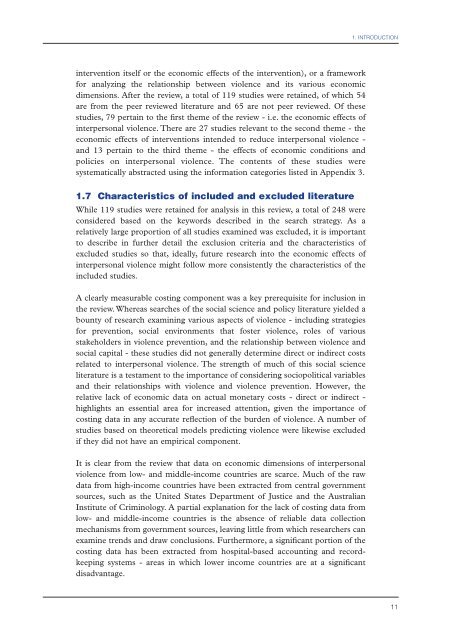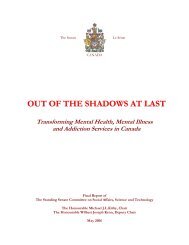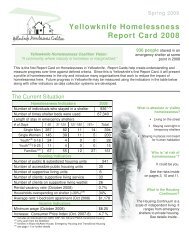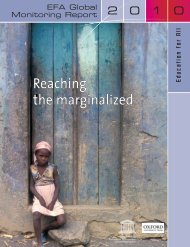The economic dimensions of interpersonal violence - libdoc.who.int ...
The economic dimensions of interpersonal violence - libdoc.who.int ...
The economic dimensions of interpersonal violence - libdoc.who.int ...
- No tags were found...
Create successful ePaper yourself
Turn your PDF publications into a flip-book with our unique Google optimized e-Paper software.
1. INTRODUCTION<strong>int</strong>ervention itself or the <strong>economic</strong> effects <strong>of</strong> the <strong>int</strong>ervention), or a frameworkfor analyzing the relationship between <strong>violence</strong> and its various <strong>economic</strong><strong>dimensions</strong>. After the review, a total <strong>of</strong> 119 studies were retained, <strong>of</strong> which 54are from the peer reviewed literature and 65 are not peer reviewed. Of thesestudies, 79 pertain to the first theme <strong>of</strong> the review - i.e. the <strong>economic</strong> effects <strong>of</strong><strong><strong>int</strong>erpersonal</strong> <strong>violence</strong>. <strong>The</strong>re are 27 studies relevant to the second theme - the<strong>economic</strong> effects <strong>of</strong> <strong>int</strong>erventions <strong>int</strong>ended to reduce <strong><strong>int</strong>erpersonal</strong> <strong>violence</strong> -and 13 pertain to the third theme - the effects <strong>of</strong> <strong>economic</strong> conditions andpolicies on <strong><strong>int</strong>erpersonal</strong> <strong>violence</strong>. <strong>The</strong> contents <strong>of</strong> these studies weresystematically abstracted using the information categories listed in Appendix 3.1.7 Characteristics <strong>of</strong> included and excluded literatureWhile 119 studies were retained for analysis in this review, a total <strong>of</strong> 248 wereconsidered based on the keywords described in the search strategy. As arelatively large proportion <strong>of</strong> all studies examined was excluded, it is importantto describe in further detail the exclusion criteria and the characteristics <strong>of</strong>excluded studies so that, ideally, future research <strong>int</strong>o the <strong>economic</strong> effects <strong>of</strong><strong><strong>int</strong>erpersonal</strong> <strong>violence</strong> might follow more consistently the characteristics <strong>of</strong> theincluded studies.A clearly measurable costing component was a key prerequisite for inclusion <strong>int</strong>he review. Whereas searches <strong>of</strong> the social science and policy literature yielded abounty <strong>of</strong> research examining various aspects <strong>of</strong> <strong>violence</strong> - including strategiesfor prevention, social environments that foster <strong>violence</strong>, roles <strong>of</strong> variousstakeholders in <strong>violence</strong> prevention, and the relationship between <strong>violence</strong> andsocial capital - these studies did not generally determine direct or indirect costsrelated to <strong><strong>int</strong>erpersonal</strong> <strong>violence</strong>. <strong>The</strong> strength <strong>of</strong> much <strong>of</strong> this social scienceliterature is a testament to the importance <strong>of</strong> considering sociopolitical variablesand their relationships with <strong>violence</strong> and <strong>violence</strong> prevention. However, therelative lack <strong>of</strong> <strong>economic</strong> data on actual monetary costs - direct or indirect -highlights an essential area for increased attention, given the importance <strong>of</strong>costing data in any accurate reflection <strong>of</strong> the burden <strong>of</strong> <strong>violence</strong>. A number <strong>of</strong>studies based on theoretical models predicting <strong>violence</strong> were likewise excludedif they did not have an empirical component.It is clear from the review that data on <strong>economic</strong> <strong>dimensions</strong> <strong>of</strong> <strong><strong>int</strong>erpersonal</strong><strong>violence</strong> from low- and middle-income countries are scarce. Much <strong>of</strong> the rawdata from high-income countries have been extracted from central governmentsources, such as the United States Department <strong>of</strong> Justice and the AustralianInstitute <strong>of</strong> Criminology. A partial explanation for the lack <strong>of</strong> costing data fromlow- and middle-income countries is the absence <strong>of</strong> reliable data collectionmechanisms from government sources, leaving little from which researchers canexamine trends and draw conclusions. Furthermore, a significant portion <strong>of</strong> thecosting data has been extracted from hospital-based accounting and recordkeepingsystems - areas in which lower income countries are at a significantdisadvantage.11
















